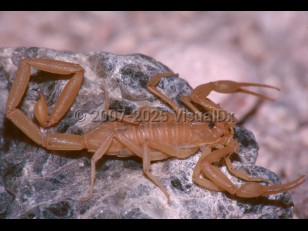Scorpion sting in Adult
Synopsis

Scorpions are members of the arthropod phylum, which includes insects, spiders, crustaceans, and other similar creatures that have segmented bodies with appendages on each segment. There are over 2000 species of scorpions, and they vary in size from a few millimeters to 15 centimeters. There are 30-35 species of scorpions of medical significance. Scorpions are solitary creatures that are active at night and hide during the day, and most species are heat tolerant. Scorpions are found on all continents except Antarctica, and they are frequently introduced to regions where they are not natively found. They can occupy many different geographical zones, having been found deep in cave systems, up to the peaks of the Andes mountains, and the canopy of rainforests.
The segmented "tail" of a scorpion ends in a vesicle that stores venom within the telson (stinger). Muscular action squeezes venom through twin openings at the base of the sting, and then the venom travels through the sting to its tip. When provoked, the scorpion uses the sting to pierce the skin of its victim and inject the venom. The size of the scorpion does not correlate with the potency of venom. Some generalities can be made from the pincher to wrist ratio, with a pincher length greater than 2 times the wrist length indicative of a more potent neurotoxic scorpion.
Scorpion envenomation is responsible for more deaths than any other venomous arthropods. Worldwide, approximately 5000 people die annually from scorpion stings, most stung by one of approximately 30-35 dangerous scorpion species. Serious envenomation typically affects the very young, old, and infirm. Most people die from excessive stimulation of the sympathetic nervous system resulting in respiratory, cardiovascular, and central nervous system failure culminating in pulmonary edema and potentially death. Anaphylaxis is rare.
Envenomation from a scorpion sting initially causes significant pain at the puncture site, and the pain can increase markedly with tapping lightly over the wound. Local pain and paresthesia can extend proximally along the limb for several hours and then will gradually retreat. There will be little to no local inflammation at the sting site.
Scorpion venom is quite variable from species to species but primarily contains neurotoxins. The neurotoxins block ion channels, particularly sodium and potassium, causing pain and paresthesia. Secondary systemic effects are caused by a massive release of acetylcholine and catecholamines. Binding of the venom to sodium channels is enhanced by the acidity of the venom. The venom generally lacks locally active toxins to produce tissue destruction.
With systemic envenomation, transient release of excessive acetylcholine can cause salivation, lacrimation, emesis and bronchorrhea (similar to "DUMBBBELS" syndrome), and muscle contraction. Bronchorrhea and bronchospasm are the most worrisome of these symptoms (known as the "killer Bs"). Subsequently, excessive norepinephrine is released and can cause significant hypertension, tachycardia, hyperthermia, diaphoresis, and myocardial depression. Oculogyric crisis has been reported, particularly in pediatric patients. End organ damage such as pulmonary edema, myocardial infarction without thrombosis, hyperglycemia, pancreatitis, and ischemic stroke may occur with severe envenomation. When the central nervous system is involved, the patient may be confused, agitated, ataxic, and have myoclonic or dystonic movements. Systemic symptoms present in the initial 6 hours after envenomation and may last up to 24 hours. Tachycardia and paresthesias may persist up to 2 weeks.
Centruroides species are found in the southwestern United States, Mexico, and Central America. Centruroides sculpturatus (formerly included in Centruroides exilicauda), the Arizona bark scorpion, found in the southwestern United States and northern Mexico, can inflict a very painful sting. In children, severe involuntary motor activity, agitation, oculogyric crisis, and respiratory difficulties with excessive secretions can occur. In the past decade, there is one known death.
Tityus species are found in Central America, South America, and the West Indies. Systemic envenomation from Tityus trinitatis (the devil scorpion) causes pancreatitis in 80% of victims.
Mesobuthus species are found in India. Envenomation from an Mesobuthus tamulus (red scorpion) sting had a 30% fatality rate in a study done in the 1960s-1970s, but now has only a 2%-3% fatality rate with prompt treatment using vasodilators and calcium-channel blockers.
Buthus species of the Mediterranean, Leiurus species (eg, death stalker) of North Africa and the Middle East, and Androctonus species (eg, fat-tailed scorpion) of North Africa and Southeast Asia are other dangerous scorpion species.
Codes
T63.2X1A – Toxic effect of venom of scorpion, accidental, initial encounter
SNOMEDCT:
217670007 – Poisoning due to scorpion venom
Look For
Subscription Required
Diagnostic Pearls
Subscription Required
Differential Diagnosis & Pitfalls

Subscription Required
Best Tests
Subscription Required
Management Pearls
Subscription Required
Therapy
Subscription Required
References
Subscription Required
Last Updated:07/29/2024

